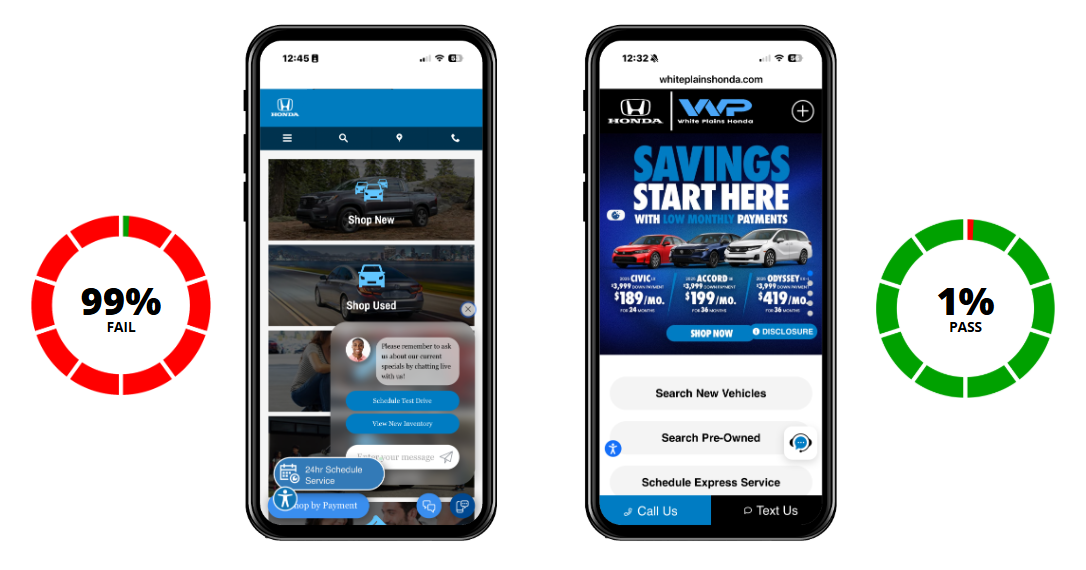Slow Sites, Lost Sales. Why 99% of Dealerships Fail Google’s Core Web Vitals
By David Boice, Co-Founder and CEO at Team Velocity
Maybe you can save yourself some time and skip reading this article. Hit ChatGPT or any of your favorite AI tools and ask:
- Why don’t car dealership websites pass Google’s core web vitals test?
- What are the benefits for car dealership websites that pass the core web vitals test?
Yeah – I know – it’s definitely not easy to pass, but the benefits of doing so are significant. Right now, the majority of dealerships’ site traffic is derived from organic and paid search. For most dealerships, organic traffic converts higher than all other sources. Google developed their Core Web Vitals (CWV) test to determine whether your website passes or fails and mobile is the default device. This test rates the performance of websites for Google’s ecosystem. In simple terms, it’s an important report card for your website.
If your website loads slowly, you’re not just frustrating visitors—you’re losing them before they even walk through your doors. Speed and performance on mobile devices isn’t just a nice-to-have; it’s a make-or-break feature that impacts everything from visibility to conversions. Here’s why every millisecond matters more than ever in 2025.
The Hard Truth: Only 1% of Dealership Sites Pass
Recent research shows only 1% of dealership websites meet Google’s Core Web Vital standards, the most basic benchmarks for site speed and performance. Why so low?

- Heavy use of third party widgets and scripts: Every single widget and script competes for load time, which leads to…absolutely nothing loading quickly.
- Template bloat from legacy providers: Many legacy website providers use old templates to display content. These are not even close to being optimized.
- Massive photo and video files: When you don’t compress your media, it takes a painful amount of time to load. Every page, every time. No
- Overuse of tracking platforms, tag managers, and ad tech: Disconnected tech comes back into play here. Multiple platforms will always compete for load time.
- Poor mobile optimization: Desktop-first designs don’t usually account for mobile experiences (or, they don’t do it well). Clunky designs, buttons you can’t touch, and heavy load times.
- Gaps in ongoing optimization: Even with a great launch and initial performance, sites can degrade over time. Constant optimization is an often overlooked, necessary maintenance to keep your site up to speed.
…and on, and on, and on. The result? Sluggish load times and terminally frustrated shoppers. Passing Core Web Vitals isn’t about bragging rights. It’s about sending a clear signal to both your team, your customers and Google’s algorithms: your digital storefront is built to perform, built to convert, and built for a friction-free experience.
Why Does This Matter?
Improved SEO and Search Ranking
Google’s Core Web Vitals are performance benchmarks designed to measure how quickly and smoothly a site loads and responds. With only 1% of dealership websites meeting these standards, those who do are rewarded with better rankings. This test is part of their algorithm. By passing, that means more traffic without spending more on advertising. In a market where most shoppers begin their journey online, appearing higher in organic search results is one of the easiest ways to increase quality traffic and increase opportunities. Google doesn’t create more shoppers, it just favors the sites that pass their tests. Think of it as a tie breaker, where the fastest cleanest sites win.
Do we even need to review #2 – #5?
Lower Bounce Rates
Today’s shoppers expect instant access to listings, photos, and vehicle details and are less patient on mobile devices. A delay of even a few seconds can cause them to leave before they’ve looked at a single car. This is especially critical for automotive shoppers, who typically browse five to ten vehicles in a single session. If your site can’t keep up, they’ll move on to one that can—often a direct market competitor. Fast-loading pages keep visitors engaged longer, giving you more chances to capture their interest and their business.
Optimized Mobile Experience
Most automotive shoppers start their buying journey on a mobile device. Meeting mobile Core Web Vitals ensures smoother scrolling, faster interactions, and fewer image-loading glitches. A fast mobile experience means customers spend more time browsing, interacting, and moving through the buying process. More than 50% of consumers won’t even consider buying from a brand with a poorly designed mobile site. Mobile performance can no longer be an afterthought—it’s the primary driver of online engagement for dealerships.
Higher Conversion Rates
When it comes to website performance, every millisecond counts. Google’s research shows that even a one-second delay in load time can reduce conversions by 20%. In the context of a dealership website, that means fewer form fills, fewer credit checks, and fewer test-drive bookings. Every interaction—whether it’s “Book a Test Drive,” “Get a Quote,” or “Check My Credit”—relies on speed to keep the customer moving forward. Faster sites close more deals, plain and simple.
Increased Consumer Trust is a Competitive Advantage
Shoppers naturally trust brands with high-performing, clean, professional websites. A smooth, responsive experience tells visitors that your dealership values their time and invests in quality—both in your technology and in your customer service. For high-value purchases like vehicles, this perception directly impacts willingness to buy. A slow, clunky, disconnected website sends the opposite message and can undermine all of your other marketing efforts.
The Bottom Line
If only 1% of dealerships are passing Core Web Vitals today, that tells us something: the industry can do better.
Website speed is more than a technical spec—it’s a sales strategy. Dealers who prioritize it consistently win more leads, more conversions, and more market share. At Team Velocity, we see speed as one of the most critical areas for improvement in automotive retail, and we’re committed to leading the way. With Apollo Sites, we are consistently passing the benchmark by deploying better code and developing applications that are natively built in into the site itself, not bolted on.
Apollo Sites is built to pass and exceed Core Web Vitals and deliver the seamless, high-performance experience today’s shoppers demand. The increase in the highest converting traffic (organic) is helping our dealers win. Let’s talk.
Source: LinkedIn



